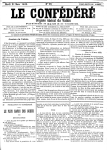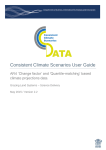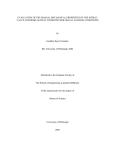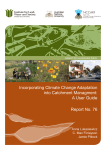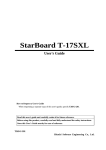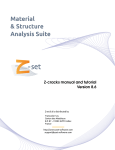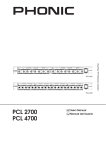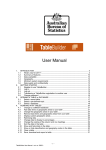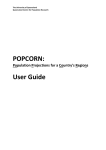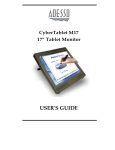Download Adapted future landscapes – User guide
Transcript
Adapted future landscapes – User guide Wayne Meyer ADAPTED FUTURE LANDSCAPES User guide University of Adelaide Wayne Meyer Published by the National Climate Change Adaptation Research Facility 2013 ISBN: 978-1-925039-72-6 NCCARF Publication 101/13 Australian copyright law applies. For permission to reproduce any part of this document, please approach the authors. Please cite this report as: Meyer, W 2013, Adapted future landscapes - User guide, National Climate Change Adaptation Research Facility, Gold Coast, 19 pp. Acknowledgement This work was carried out with financial support from the Australian Government (Department of Climate Change and Energy Efficiency and the National Water Commission) and the National Climate Change Adaptation Research Facility (NCCARF). The role of NCCARF is to lead the research community in a national interdisciplinary effort to generate the information needed by decision-makers in government, business and in vulnerable sectors and communities to manage the risk of climate change impacts. Disclaimer The views expressed herein are not necessarily the views of the Commonwealth or NCCARF, and neither the Commonwealth nor NCCARF accept responsibility for information or advice contained herein. Material contained within this publication contains information based on modelling and scientific research. The reader is advised and needs to be aware that such information may not be complete or unable to be used in any specific situation. No reliance or actions must therefore be made on that information without seeking prior expert professional, scientific and technical advice. To the extent permitted by law, affiliated corporations are not held liable for any consequences, including but not limited to all loses, damages, costs, expenses and any other compensation, arising directly or indirectly from using this publication (in part or in whole) and any information or material contained in it. Cover image © Kyle Taylor, Flickr Creative Commons TABLE OF CONTENTS 1 About this User Guide ............................................................................................ 1 1.1 Adapted future landscapes ............................................................................. 1 1.2 The software ................................................................................................... 1 1.3 Structure of the user guide.............................................................................. 2 2 Getting started ....................................................................................................... 3 3 Planning modules within the software .................................................................... 4 4 5 3.1 Scenarios ....................................................................................................... 4 3.2 Agricultural management ................................................................................ 4 3.3 Carbon sequestration ..................................................................................... 5 3.4 Biodiversity conservation ................................................................................ 7 3.5 Weed risk ....................................................................................................... 8 Applying the Adapted Future Landscapes process .............................................. 10 4.1 Defining the purpose of the application ......................................................... 10 4.2 What do you really want the landscape to be like? ....................................... 10 4.3 Discussion of the scenarios that underpin the software ................................ 11 Access to LFAT ................................................................................................... 13 5.1 Non-Commercial Use: .................................................................................. 13 5.2 Commercial Use: .......................................................................................... 14 References ................................................................................................................. 15 Appendix 1. Envisioning.............................................................................................. 16 Introduction to envisioning ....................................................................................... 16 Recommended process for engaging with natural resource management regions .. 17 Adapted future landscapes user guide i 1 ABOUT THIS USER GUIDE 1.1 Adapted future landscapes The assessment of a range of possible landscape futures can aid natural resource management (NRM) planning and support investment decision-making. Informed planning and decision-making is required soon if Australia’s regions are to adapt to global challenges such as climate change. Spatially-explicit and quantitative datasets which make up landscape futures analysis are essential information for supporting regional planning for adapted futures. This User Guide describes the Adapted Future Landscapes approach to support NRM planning and decision-making. This approach combines application of the Landscape Futures Analysis Tool (LFAT), the use of which is described in this User Guide, as well as a process for engaging stakeholders in determining their vision for the landscape, an important precursor to use of LFAT. 1.2 The software Past engagement with potential users of Landscape Futures Analysis revealed that whilst the information generated was of great interest to them, standard forms of communication and delivery such as static maps in reports or presentations were inflexible and formed a barrier to its use in decision-making and planning processes. The LFAT software puts landscape futures information into the hands of natural resource managers and decision-makers for closer investigation and analysis. The current version of the LFAT has been developed for two NRM regions: 1. Eyre Peninsula (EP); and 2. South Australian Murray-Darling Basin (SA MDB); Both of these regions are dominated by agricultural land use—and both will be affected by external market and policy drivers. The LFAT enables regional natural resource managers to explore the impact of climate, carbon price and agricultural commodity price scenarios on four key land management options: 1. Agriculture - continuation of traditional agriculture 2. Storing carbon—finding “go” and “no-go” zones for carbon plantations 3. Conserving biodiversity—managing remnants and restoring corridors 4. Managing weeds—targeted management of future invasion risk hotspots The software allows for consideration of issues relevant to freshwater biodiversity such as groundwater recharge potential and the location of wetlands in the landscape (e.g. as part of “no go” and “go” zones for carbon sequestration; see later sections for more explanation). Adapted future landscapes user guide 1 1.3 Structure of the user guide The User Guide is structured as follows: • Getting started – System and browser requirements for accessing the LFAT. • The modules – Overview of the policy and market variables that underpin the scenarios and explanation of the structure and functionality of the four land management modules in the LFAT. • Applying the Adapted Future Landscapes process – Description of how to use the LFAT as part of a broader planning process. • Access to LFAT – Description of the conditions regarding commercial and noncommercial use of the LFAT. A detailed tutorial on use of the LFAT is presented at Appendix A. This provides an extensive description of how to use the different functions available for the tool. Much of the information presented in this User Guide and the Appendix tutorial is also available by clicking the help icons in the LFAT. 2 Adapted future landscapes user guide 2 GETTING STARTED The Landscape Future Analysis software has been built on an ESRI ArcGIS 10 SP2 web server. The server enables the creation and distribution of geospatial web services in order to visualise, manage and undertake spatial analysis of geographic data. The URL for accessing the software is: http://www.lfat.org.au/lfat/. Users require a username and password to access the site. These are provided by the LFAT Administrator who can be contacted on [email protected]. The browser on the user’s system needs to be able to run HTML5 or Chrome frame. Browser options to do this include: • • • • • Internet Explorer 9 and 10 Google Chrome Safari Opera, Firefox Note that Internet Explorer 7 and 8 do not run HTML5 and hence cannot be used to access the site. This can be overcome by installing Google Chrome frame which does not generally require Administrator access for installation on desktop machines. Adapted future landscapes user guide 3 3 PLANNING MODULES WITHIN THE SOFTWARE 3.1 Scenarios LFAT contains four modules through which users can explore the impact of future climate change, agricultural commodity price and carbon price scenarios on a range of land management alternatives. These variables underpin the modelling for different indicator layers and are described as follows: • • • Four climate scenarios: o S0 Baseline: Historical climate o S1 Mild warming/drying: +1 degree, 5% reduction in rainfall and 480ppm CO2 o S2 Moderate warming/drying: +2 degrees, 15% reduction in rainfall and 550ppm CO2 o S3 Severe warming/drying: +4 degrees, 25% reduction in rainfall and 750ppm CO2 Four agricultural commodity price scenarios are considered, based on 0.5x, 1.0x, 1.5x, and 2.0x 2012 prices. Four carbon price scenarios are considered, based on 15, 30, 45 and 60 $/t CO2-equivalent. All modules enable users to visualise the data and orient themselves by displaying the following underpinning data layers: towns, roads, land parcels, and aerial/satellite imagery. 3.2 Agricultural management The agricultural module supports planning for agriculture by exploring the potential impacts of climate change on production factors such as wheat yields. The interface considers a number of criteria including prime agricultural land and economic potential and trade-offs in the face of changing climate and prices for commodities and carbon. The software enables the user to integrate landscape futures information with their own knowledge and experience to evaluate options for future farming systems, although not at a property level. A typical goal would be: To identify areas of land where the future economic production from cropping remains positive under a range of climate change scenarios. The software provides the ability to overlay a range of criteria layers that describe the spatial distribution of a selected indicator for each criterion. The indicator layers provided within the software are: • 4 Agricultural production –APSIM (Agricultural Production Systems sIMulator) modelled wheat yield (kilograms/ha/year) over agricultural regions. Layers of information are available for the baseline climate (S0), mild (S1), moderate (S2) and severe (S3) climate change scenarios. (APSIM was developed to simulate biophysical processes in farming systems, particularly as it relates to the Adapted future landscapes user guide economic and ecological outcomes of management practices in the face of climate risk. 1) • Agricultural Value: Net Present Value of agriculture over 64 years ($/ha) under the specified climate, agriculture price and cost scenarios. Calculated as yield (tonnes/ha) multiplied by the average commodity price over 10 years minus the costs of agricultural production using a discount rate of 7%. • Mean Annual Temperature: ESOCLIM software was used to model mean annual temperature (°C) based on historical minimum and maximum temperature data under the baseline climate scenario, with increases in temperature calculated for each climate change scenario. ESOCLIM generated temperature data was used in the forest/carbon productivity modelling that used the 3PG2 model; see the next section. • Annual Rainfall: ESOCLIM software was used to model total annual rainfall (mm/year) based on historical rainfall data under the baseline climate scenario, with reductions in rainfall calculated for each climate change scenario. ESOCLIM generated rainfall data was used in the forest/carbon productivity modelling that used the 3PG2 model; see the next section. 3.3 Carbon sequestration The software enables the user to integrate landscape futures information with their own knowledge and experience to evaluate options for locating carbon plantations. A typical goal would be: To restrict carbon plantations to acceptable areas (i.e. “go zones”) to support other planning goals. For example, natural resource managers may want to identify areas that satisfy some combination of being privately-owned, with higher carbon sequestration potential, are at risk of wind erosion, do not affect water resources, are not prime agricultural land, do not preclude future restoration in high biodiversity priority areas, have significant economic potential, and do all this under a range of possible climate futures. The carbon sequestration module supports spatial planning for the reforestation of carbon plantations of fast-growing Eucalyptus species for the sequestration of carbon in biomass. The indicator layers provided within the software are: 1 • Carbon Value NPV: Net Present Value of carbon plantings over 64 years ($/ha) under the specified climate, carbon price and cost scenarios. Calculated as the carbon dioxide equivalent sequestered (tonnes CO2-e/ha) multiplied by the carbon price minus the costs of establishing and maintaining carbon plantations using a discount rate of 7%. The 64 year time is a nominal period deemed to be sufficient to provide a “long term” projection and consistent with agricultural planning horizons and the expected carbon sequestration life of trees if they are part of the production system. Similarly the 7% discount rate is nominal and consistent with usual accounting practice for agricultural and natural resource accounting. • Carbon Sequestration Potential: Total tonnes of carbon dioxide equivalent sequestered by carbon plantations over 64 years (tonnes CO2-e/ha). Forest http://www.asris.csiro.au/downloads/ApsimFactSheet.pdf Adapted future landscapes user guide 5 biomass estimates were modelled using 3PG2 and converted to CO2-e using the formula: E = (WF + WR + WS) x 3.67/2, where: E = Carbon dioxide equivalent sequestered WF = Foliage biomass from 3-PG2 (tonnes dry matter/ha) WR = Root biomass from 3-PG2 (tonnes dry matter/ha) WS = Stem biomass from 3-PG2 (tonnes dry matter/ha); 6 • Agricultural production –APSIM (Agricultural Production Systems sIMulator) modelled wheat yield (kilograms/ha/year) over agricultural regions. Layers of information are available for the baseline climate (S0), mild (S1), moderate (S2) and severe (S3) climate change scenarios. • Agricultural Value: Net Present Value of agriculture over 64 years ($/ha) under the specified climate, agriculture price and cost scenarios. Calculated as yield (tonnes/ha) multiplied by the average commodity price over 10 years minus the costs of agricultural production using a discount rate of 7%. • Net Returns: Calculated as the economic return ($/ha) to carbon plantations minus economic returns to agriculture under the specified climate, agriculture price, cost and carbon price scenarios. Positive values represent areas where carbon plantations are estimated to be more profitable than traditional agriculture, with negative values representing areas where traditional agriculture is estimated to be more profitable than carbon plantations. This is calculated as the annualised return based on costs and returns over a 64 year period. • Biodiversity Benefit: Areas are ranked on a scale of one (low importance) to 10 (very high importance) for native plant species conservation. This gives landscape conservation prioritisation that is based on the current distribution of native plant species under the baseline climate and the predicted distribution under the climate change scenarios. • Fire Risk: Straight line distance from urban centres calculated using a GIS. Underlying data is the Australian Standard Geographical Classification (ASGC) Urban Centres and Localities (UC/L) Digital Boundaries dataset, sourced from the Australian Bureau of Statistics (ABS). • Dryland Salinity: The risk of dryland salinity layer was constructed using the combination of deep drainage consequence and likelihood under the specified climate scenario. The consequence layer was based on the depth to groundwater, while the likelihood was calculated as the amount of deep drainage occurring based on APSIM (Agricultural Production Systems sIMulator) modelling. Areas with substantial deep drainage and shallow depth to groundwater were classified as high risk for dryland salinity. • Soil Erosion: A map of soil wind erosion potential was derived from erosion risk attributes contained within the South Australian soil data compiled by the South Australian Department of Primary Industries. Soil wind erosion potential is classified into six classes from low risk to extreme risk. Adapted future landscapes user guide • Groundwater recharge: Groundwater recharge areas are classified as having a low, moderate or high recharge potential. This classification was sourced from the South Australian Land and Soil database published by the Department of Environment, Water and Natural Resources. Recharge potential was calculated as a function of soil water holding capacity, substrate porosity and rainfall. • Wetlands: Data layers were sourced from the Directory of Important Wetlands in Australia to identify important wetlands within the study region. These are areas of marsh, peatland or water, which can be natural or artificial in origin. The wetlands can be permanent or perennial; comprised of static or flowing; and fresh or salt water. A set of criteria were used to determine if identified wetlands were classified as nationally important wetlands based on their environmental, ecological, hydrological, historical or cultural significance. The carbon sequestration module contains a “Carbon sequestration GO/NO GO” layer that dynamically calculates the areas in which carbon plantings can (“go”) and should not (“no go”) be established, using a multi-criteria analysis approach where suitable areas for selected criteria are defined by user-selected thresholds. This considers all other selected layers (through checking a tick box) and enables users to determine where to plant trees for generating carbon offsets in a way that minimises impacts on, for example, agriculture, water supply catchments and fire risk. 3.4 Biodiversity conservation The software supports spatial planning for remnant vegetation management and the establishment of corridors, considering the benefits for biodiversity and economic trade-offs. The interface enables users to integrate landscape futures information with their own knowledge and experience to evaluate options for managing remnants and establishing corridors. A typical goal would be: To identify areas for management and restoration that maximise biodiversity benefit and minimise the loss to agricultural production. Users can also make investment and allocation decisions that are most robust to future climate change. Users have a choice of the following indicator layers: • Biodiversity Benefit: Areas are ranked on a scale of one (low importance) to 10 (very high importance) for native plant species conservation. This gives landscape conservation prioritisation that is based on the current distribution of native plant species under the baseline climate and the predicted distribution under the climate change scenarios. • Species Distribution: Projected species distributions for individual native plant species under baseline, mild, moderate and severe climate change. The number of species for which distributions are available varies between regions. • Agricultural production: APSIM (Agricultural Production Systems sIMulator) modelled wheat yield (kilograms/ha/year) over agricultural regions. Layers of information are available for the baseline climate (S0), mild (S1), moderate (S2) and severe (S3) climate change scenarios. • Agricultural Value: Net Present Value of agriculture over 64 years ($/ha) under the specified climate, agriculture price and cost scenarios. Calculated as yield Adapted future landscapes user guide 7 (tonnes/ha) multiplied by the average commodity price over 10 years minus the costs of agricultural production using a discount rate of 7%. • Environmental Plantings Value NPV: Net Present Value of environmental plantings over 64 years ($/ha) under the specified climate, carbon price and cost scenarios. This total over time is calculated as the carbon dioxide equivalent sequestered (tonnes CO2-e/ha) multiplied by the carbon price minus the costs of establishing and maintaining environmental plantations using a discount rate of 7%. • Incentive Payment: The potential incentive payment required for landholders to switch from agriculture to environmental plantings ($/ha) under the specified climate, agriculture price, cost and carbon price scenarios. Calculated as the Net Present Value of agriculture minus the Net Present Value of environmental plantings over 64 years. Areas where the potential returns to environmental plantings are higher than agriculture (returning a minus incentive payment value) are symbolized as “No Payment Required”. Based on information from the above layers, users can identify, map, analyse, and compare areas for both managing remnants, and for restoration of cleared agricultural land to create corridors which link remnants. To do this, users can: • Identify areas of vegetation polygons for management agreements using the area selection tool on the screen. • Identify areas of cleared agricultural land for environmental plantings and ecological restoration using the area selection tool on the screen i.e. private land of high biodiversity benefit and low opportunity cost. Not all of the species within a region are presented in the LFAT. This could be because they are not influenced by projected changes in climate or because insufficient data was available to enable modelling to be done. It should also be noted that there may be species currently in other regions that will enter the target region under future climate change as conditions become more favourable. Such species have not currently been identified in the LFAT. 3.5 Weed risk The weed risk module enables the targeted management of future invasion risk hotspots. The software supports spatial planning for prioritising weed management efforts based on understanding how future changes in climate will advantage or disadvantage the spread of selected agricultural and environmental weed species. The interface enables users to integrate landscape futures information with their own knowledge and experience to evaluate options for managing problem weeds. A typical goal would be: To identify areas for management that focus efforts on “hotspots” where multiple problem weeds can be targeted for management in one location. Users have a choice of the following indicator layers: • 8 Agricultural production: APSIM (Agricultural Production Systems sIMulator) modelled wheat yield (kilograms/ha/year) over agricultural regions. Layers of information are available for the baseline climate (S0), mild (S1), moderate (S2) and severe (S3) climate change scenarios. Adapted future landscapes user guide • Agricultural Value: Net Present Value of agriculture over 64 years ($/ha) under the specified climate, agriculture price and cost scenarios. Calculated as yield (tonnes/ha) multiplied by the average commodity price over 10 years minus the costs of agricultural production using a discount rate of 7%. • Biodiversity Benefit: Areas are ranked on a scale of one (low importance) to 10 (very high importance) for native plant species conservation. This gives landscape conservation prioritisation that is based on the current distribution of native plant species under the baseline climate and the predicted distribution under the climate change scenarios. • Weed Species Habitat Suitability: Projected species distributions for individual weed species under the baseline, mild, moderate and severe climate change scenarios. Not all of the species within a region are presented in the LFAT. This could be because they are not influenced by projected changes in climate or because insufficient data was available to enable modelling to be done. This could preclude rare or uncommon species that may be favoured by future climate. It should also be noted that there may be species currently in other regions that will enter the target region under future climate change as conditions become more favourable. Such species have not currently been identified in the LFAT. The weed risk module also contains a series of layers that can be dynamically calculated to identify hot spots for weed management. Hot spots are identified based on areas where multiple weed species have high habitat suitability scores. The layers are: • Weed Risk Hotspots: Calculated as the sum of all individual weed species layers selected, divided by the number of weed species selected; • Agricultural Weed Risk: This layer is calculated by multiplying the Weeds Hot Spot analysis layer with the Agricultural Production layer and rescaling the resulting layer to a common scale from low risk to extreme risk; and • Ecological Weed Risk: Result layer for the Ecological Risk model. This layer is calculated by multiplying the Weeds Hot Spot analysis layer with the Biodiversity Benefit layer and rescaling the resulting layer to a common scale from low risk to extreme risk. Based on information from the above layers, users can identify, map, analyse, and compare areas for both managing remnants, and for restoration of cleared agricultural land to create corridors which link remnants. To do this, users can: • Identify areas for land management using the area selection tool on the screen. • View aggregate statistics such as area selected, vegetation types, land tenure, weed risk score. Adapted future landscapes user guide 9 4 APPLYING THE ADAPTED FUTURE LANDSCAPES PROCESS Application of the Adapted Futures Landscape process is usually by way of engagement of end users in a series of workshops which seek to identify the purpose of the planning exercise, the overarching goals of planning, use of the software and then generation of outputs - typically as maps, that can be used to inform decision making or assist with more general education and awareness raising. 4.1 Defining the purpose of the application The Adapted Future Landscapes process, including use of the LFAT, can be applied for a range of purposes and for a range of target audiences. Understanding the purpose and target audience will influence the design of the process. Potential users of the process include: • NRM Board, • NRM planners, • Pest plant managers, • Biodiversity managers, • Water resource planners, • Emergency management, • Farmers, • Broader community, and • Applicants for biodiversity or carbon planting funding. Potential applications of the process include: • Awareness raising, • NRM planning and implementation, • Investment prioritisation, and • On-ground management prioritisation. In some instances managers with specific responsibilities will have clear directions as to what their goals are. This will allow for more direct use of LFAT with less of a requirement for broader community engagement. For example, a pest plant manager who wants to identify hotspots for focussing management efforts in the coming 5 years. In other instances, such as during development of an NRM Plan, a broader, collective understanding of the vision of stakeholders for their region is required before application of LFAT. This would require greater work through a process like envisioning combined with application of LFAT. 4.2 What do you really want the landscape to be like? It is widely accepted that a vision of a better future can play a powerful role in leadership and mobilising people to change. Engaging people through envisioning can result in greater commonality of views and an agreed vision. Identifying a vision for future management of a region is an important pre-cursor to using the Landscape Futures Analysis software. It provides a reference point for the choices that will need to be made about what combination of future land management actions, climate, commodity price and carbon price should be explored with the software. 10 Adapted future landscapes user guide In conventional planning processes the vision is often a very short statement at the beginning. It is then left behind as the planning process moves in a linear fashion towards determining goals and actions. Our research has developed an envisioning process that is founded upon the principles of complex ‘living’ systems, and so is appropriate where various social structures and dynamics interact with the regional landscape. The process employs shared vision, values, indicators and ‘action learning’ processes that enable us to learn our way to bringing the vision into being. It is unfamiliar to most participants. Other ‘systemic’ engagement processes such as Appreciative Inquiry may also be suitable where an NRM Board and community do not have access to the envisioning process. The important characteristics of an effective process are that it: • Reflects the behaviour of complex living systems, that is, it acknowledges that we cannot predict or predetermine outcomes in the longer-term and we do not know in advance what path we need to follow. Instead, we bring to bear an experimental ‘learning’ attitude (this directly challenges most current approaches to ‘strategic planning’, which assume that the future can be predetermined, ‘planned’ for and reliably controlled). • Engages the whole system (not just the planners) because the nature of the change is “adaptive” (Heifetz et al. 2009) and an adaptive change requires people to change their own hearts and minds about the matter – it cannot be forced on them by ‘telling’ or legislating. By engaging the whole system in this way, planning and implementation may be seen as the same activity. • Engages representatives of the whole system across more traditional planning silos, defined by environmental assets such as soils, water, weeds, to shape a holistic approach rather than a ‘reductionist’ or fragmented approach. • Integrates LFAT into the engagement process in a way that recognises that the scientific contribution is not the whole story – the community needs to integrate the science with other data (and other knowledge of managing the land, such as the knowledge held by local land managers and indigenous people) in deciding how they will try to bring their vision into being, with all its embedded values – a vision of how they want to experience their landscape together. • Engages people in such a meaningful and joyful way that they wish to remain engaged. This is an engagement process at the right hand end of the International Association for Public Participation’s spectrum – known as ‘empowering’. We recommend that an engagement process following these principles be used to determine how the community wishes to experience the (a) planning process and (b) landscape. Users of the Adapted Landscapes Futures approach may consider various methods for developing a vision and land and water management goals. The envisioning process described in the appendix is one choice available to practitioners. 4.3 Discussion of the scenarios that underpin the software Underpinning the LFAT is a series of scenarios based on three drivers: climate, commodity price and carbon price. If the Adapted Future Landscapes process is being run via a facilitated workshop process time should be allocated to explain what the Adapted future landscapes user guide 11 scenarios are and how they function within the LFAT. Understanding of the scenarios is important because combinations of climate, commodity and carbon price scenarios can lead to very different software outputs and consequently may lead to different planning or management decisions. Climate change scenarios: Four climate change scenarios are considered in the underlying Landscape Futures Analysis model: • • • • Current - S0 Baseline: Historical climate Mild - S1 Mild warming/drying: +1°C warming, 5% reduction in rainfall and atmospheric concentrations of CO2 rise to 480 ppm Moderate - S2 Moderate warming/drying: +2°C warming, 15% reduction in rainfall and atmospheric concentrations of CO2 rise to 550 ppm Severe - S3 Severe warming/drying: +4°C warming, 25% reduction in rainfall and atmospheric concentrations of CO2 rise to 750 ppm Agricultural commodity price: Four agricultural commodity price scenarios are considered by the underlying Landscape Futures Analysis model: 0.5x (half), 1.0x (current), 1.5x (one and a half), and 2.0x (double) 2012 prices for wheat, wool, and sheep meat. • • For the Eyre Peninsula, commodity prices are based on wheat, meat (mutton and lamb) and wool prices using ABARE and ABS data from 2001-02 to 201011. For the South Australian Murray-Darling Basin, commodity prices are based on wheat, lupins, meat (mutton and lamb) and wool prices using ABARE and ABS data from 2001-02 to 2010-11. In producing outputs, the underlying model differentiates between grazing and cropping areas and applies the appropriate pricing i.e. wheat and lupin prices on cropping land and wool and meat prices on grazing land. Wheat, lupin and wool prices have been sourced from the Department of Agriculture, Fisheries and Forestry - ABARE website and mutton and lamb prices sourced from the Meat and Livestock Australia website. Carbon price: Four carbon price scenarios are considered by the underlying Landscape Futures Analysis model: $15/tCO2-e, $30/tCO2-e, $45/tCO2-e, $60/tCO2-e. The carbon price scenarios were developed in the context of projected carbon prices at the time of the modelling being undertaken, when during the flexible price period of the carbon pricing scheme, the upper limit on the carbon price was going to be $29t/CO2e and the lower limit $15t/CO2e. The upper and lower price bands have now been removed and the Australian carbon market will be linked with European Union emissions trading scheme as of 2015-16. Some analysts suggest that when this does occur, carbon prices will be close to $15/ CO2e. In considering which carbon price scenario to adopt, users must make their own assessment about how much carbon price will rise into the future. 12 Adapted future landscapes user guide 5 ACCESS TO LFAT LFAT aims to support NRM planning and decision making by government agencies and other interested stakeholders. This is encouraged through broad licensing of the LFAT software. LFAT is available either for non-commercial or commercial purposes, through the University of Adelaide and CSIRO Ecosystem Sciences. Through this framework, the intent is to develop a high-quality and enduring landscape systems modelling platform with national relevance. All access will be through approved licence agreements. 5.1 Non-Commercial Use: For non-commercial purposes, access to LFAT will be free of charge to 3rd parties, who in turn relinquish ownership of improvements to the University of Adelaide and CSIRO Ecosystem Sciences. Non-commercial use of LFAT means public-good research & development and educational activities. It includes the support of policy development and/or implementation by, or on behalf of, government bodies and industry-good work where the research outcomes are to be made publicly available. The University of Adelaide and CSIRO Ecosystem Sciences will provide official releases of LFAT free of charge for non-commercial use to those who agree to the terms of the license agreement. Plain English APSIM Non-Commercial Licence Summary: The following is a Plain English Version of the standard 3rd Party, Non-Commercial Licence Agreement. Please note that this summary of the Non-Commercial Licence is provided for the information of interested persons. It is not the Agreement. In the event of any disagreement between the terms of the Licence Agreement and this summary, the Agreement prevails. Any individual or organisation (a 3rd party outside of the University of Adelaide and CSIRO Ecosystem Sciences) who wants to use LFAT must be licensed do so by the University of Adelaide and CSIRO Ecosystem Sciences. Key elements of the licence are as follows: • • • • • The licence is a legally binding agreement between the licensee and the University of Adelaide and CSIRO Ecosystem Sciences. The licence agreement permits the licensee to use LFAT for research and development and for education. All commercial uses are explicitly excluded. Proposals for commercial use will be considered by the University of Adelaide and CSIRO Ecosystem Sciences but this licence will not apply. Separate agreements will be negotiated on a case-by-case basis. The standard licence is for a fixed term of 3 years and is renewable. The licensee's right to use LFAT ends when the licence ends. The standard licence permits LFAT to be used anywhere in Australia. Non-commercial use of LFAT is free of charge. Licensed users can use the LFAT software and models, access other LFAT intellectual property and can also access the source code of LFAT. Intellectual property rights in LFAT are retained by the University of Adelaide and CSIRO Ecosystem Sciences. If a licensee makes any improvements to LFAT, the intellectual property rights to those improvements belong to the University of Adelaide and CSIRO Ecosystem Sciences. This means that the University of Adelaide and CSIRO Ecosystem Sciences can choose to make the improvements - including source code - available to all licensed users Adapted future landscapes user guide 13 • Licence holders use LFAT at their own risk. The licensee and the University of Adelaide and CSIRO Ecosystem Sciences each take no responsibility for any loss or liability resulting from their having breached the terms of the licence agreement. The agreement requires the licensee and the University of Adelaide and CSIRO Ecosystem Sciences to negotiate in good faith to resolve any dispute. If this fails, technical questions must be adjudicated by an independent expert, while non-technical matters must be put to mediation. 5.2 Commercial Use: Use of LFAT for commercial purposes is subject to negotiation on a case-by-case basis. The terms of any commercial licence agreement will be subject to the approval of the University of Adelaide and CSIRO Ecosystem Sciences. This includes use of LFAT, parts of LFAT or derivatives by agribusiness, consultants and other organisations. Access to LFAT for commercial purposes requires submission of a formal commercialisation proposition to the University of Adelaide and CSIRO Ecosystem Sciences. The commercialisation proposition sets out the purpose or intended field of use, terms of access, and licensing arrangements. Commercial use includes use of LFAT, parts of LFAT or derivative products by agribusiness, consultants and other organisations. Issues that would need to be considered in any commercialisation proposal include: • • • • • • • • • • • Purpose Added value to business Exclusivity (generally a non-transferable, non-exclusive licence to use LFAT) Degree of support required from the University of Adelaide and CSIRO Ecosystem Sciences Access to updates Term (start and end dates) Territory Preparedness to contribute background IP (if any) to University of Adelaide and CSIRO Ecosystem Sciences Preparedness to contribute improvements (if any) to University of Adelaide and CSIRO Ecosystem Sciences Fees (may include an annual licence fee and /or royalty, training fees and support fees) Other licensing conditions The University of Adelaide and CSIRO Ecosystem Sciences will provide releases of LFAT for commercial use subject to the terms agreed in the negotiated licensing agreement. 14 Adapted future landscapes user guide REFERENCES Bass, B. (1988). The inspirational processes of leadership. Journal of Management Development, 7(5), 21-30. Heifetz, R., Grashow, A. and Linsky, M. (2009). The pratice of adpative leadership: tools and tactics for changing your organisation and the world, Boston, Harvard Business Press. Kouzes, J., & Posner, B. (2002). The leadership challenge (3rd ed.). San Francisco: Jossey-Bass. Meadows, D. (2001). 'Dancing with Systems'. Whole Earth, winter. Williams, B. K. (2011). Adaptive management of natural resources - framework and issues. Journal of Environmental Management, 92(5), 1346-1353. Adapted future landscapes user guide 15 APPENDIX 1. ENVISIONING Introduction to envisioning Adapted Future Landscapes has used a process of “envisioning” founded upon principles consistent with the behaviour of complex living systems. The envisioning process is a four stage, iterative process that takes an experimental approach, supporting ongoing action learning about how to bring a vision into being. In the fourth stage it incorporates exploration of the scenarios made possible using the LFAT, as a way of integrating ‘the science’ into the making of decisions about how to shape the future landscape. The four stages are: The Shared Vision In essence, envisioning starts as a group activity that uses the selection of images by each individual in the group to stimulate the development of a shared narrative about how the group want to experience the planning process or the future landscape. The shared vision is created through a facilitated process that commences as an individual’s vision and is shared through conversations on each table and then aggregated as tables share their visions. Core Messages The narrative captures the values or “core messages” that are important to the group and those core messages must now be identified, consolidated and clearly articulated. Limiting the group to identifying their top 5-7 core messages has proved useful in past work. Indicators Then follows a facilitated process to identify the “indicators”, prompted by the core messages and reflecting what will be observed as the shared vision is brought into being – these indicators attempt to capture the shift in the whole system and are often qualitative and subjective, rather than quantitative ‘measures’ of one part of the system. Action Learning integrating the LFAT scenarios Finally, decisions are made about what action to take – what we are going to try – in the light of the options generated in the LFAT. These decisions are shaped by the shared vision and its indicators, by local knowledge, and by the bio-physical limits and imperatives identified by the science. The ‘envisioning process’ assumes an ongoing engagement with the model over the long term and encourages the group to reflect upon what they have learned as a result of taking action – and incorporate this learning into the planning of subsequent action. The learning is expected to result in changes to the vision, core messages and indicators over time. The entire process is intended to be dynamic and evolving. The idea of a ‘vision’ is not new and has been explored in a number of natural resource management projects. Several features set the envisioning process apart from other approaches. • Recognition that influencing the landscape on the scale and timeframe required to adapt to climate change demands a paradigm shift – to a mindset shaped by the appreciation of complex adaptive systems or ‘complexity’ (Meadows, 2001). This shift is away from the ingrained habits of a ‘mechanistic’ view of the world, characterised by the assumption of certainty, predictability, ‘linear causation’ following discoverable ‘laws’, ‘reductionism’ (trying to understand the whole by breaking it into parts – the assumption is that the whole is just the sum of the parts), and control. • 16 A shift towards seeing the world through the lens of complexity turns these characteristics on their head. Complex systems are characterised by uncertainty, Adapted future landscapes user guide unpredictability, and ‘non-linear causation’ (as with ‘the butterfly effect’...the flapping of a butterfly’s wings on one side of the world may cause a tornado on the other side – the causal links are hidden and the scale of the effect may vary significantly from that of the cause). Because the behaviour of the system is the product of the unknowable interactions between the parts of the system, attempts to influence the system require that we learn how to engage with it as a whole, rather than trying to break it into parts. So to influence the system, we must first give up any illusion of control and then learn how to work with the powerful ‘self-organising’ forces already at work as the parts interact with each other. • The vision in an envisioning process is more than a formulaic sentence. The story is rich in values because people envision around the things they care most about. Envisioning, then, is a way of facilitating the discussion of those issues that are most important to people, and the sharing of their desired futures at the level of values. The envisioning process is more than a planning process that will develop a plan to be implemented later. It is a social change and learning process, in itself, of the kind that has been referred to as ‘adaptive management’(Williams, 2011). The shared vision is never left behind – it ‘cradles’ the entire process of planning and implementation. • The facilitated process of envisioning, of sharing stories about the things we care strongly about, is a way of revealing self to others, which builds empathy and relationships. This can assist in the group dynamics, developing a desire to bring the shared vision into being through collaboration. Facilitating a process that enables people to articulate and integrate their values, and to explore how these shared stories can shape future action, appears to be one way of facilitating cultural (and adaptive) change. Recommended process for engaging with natural resource management regions A one-size-fits-all engagement process or model that generates a single ‘blueprint’ for specific action is unlikely to produce the desired results, because of the highly variable and complex circumstances of each natural resource region. The recommended process for engagement that is outlined below reflects an awareness of those circumstances and the need to tailor or customise the approach for each region, based on an understanding of complex living systems and of the requirements for adaptive change. 1. Explore the willingness to embrace change - The process needs to engage its participants at the appropriate level of ‘willingness’ and considerable time and energy may be invested in this phase of the process. 2. Explore NRM planners’ locus of control - The locus of control perceived by local planners – Who is accountable for outcomes? Who is responsible for outcomes? Who has control of outcomes? - is an important source of variation between regions. The process needs to address perceived local constraints or limitations, especially where regional planners may have come to see their task as simply completing a ‘planning’ process (largely divorced from implementation) that meets the requirements of regulation, or of “the Minister”. 3. Determine the appropriate system to bring together - As the process sets about “bringing the whole system together” 2, attention must be given to the relationship between regional NRM organisations and their local community. How is the ‘whole system’ best 2 Bringing the whole system together is a key principle in helping the system to respond to external stimuli ( Broderick, 2005; Maturana, Varela & Uribe,1974; Wheatley,1999) Adapted future landscapes user guide 17 represented? Some local communities will feel well represented by the NRM organisation and others less so. Consideration should be given to whether the NRM organisation, alone, is the appropriate conduit for community engagement in the planning process. Should other stakeholder groups be included – e.g. Land Care groups? This is another source of regional variation that the process needs to accommodate. Everyone who is willing to participate should be invited and welcomed – this will result in the process taking longer and being more contentious, but also facilitating the adaptive change required. 4. Influence the System of Planning and Implementation - It is apparent that all levels of the planning ‘system’, from state public servants to farmers, want the planning process experienced in the same way. This common ground encompasses values such as transparency, participation, respect, honouring different kinds of knowledge (local, indigenous and scientific) and autonomy to respond to complex bio-socio-economic environments (values that are consistent with the governance framework for NRM boards proposed by Lockwood, Davidson, Curtis, Stratford, & Griffith, 2010). Nevertheless, it is clear that many participants do not experience planning in this way. The process of planning and implementation built on and informed by co-created vision is designed so that it can deliver the experience of these core values to all participants. The process recommended also exposes participants to complexity theory and its implications for management and planning. This will help participants to become aware of existing ‘mental models’ and to challenge some deeply held beliefs and assumptions about how the world operates. 5. Capacity Building, Complexity and the Role of Envisioning - Envisioning has the capacity to identify common ground among diverse stakeholders and to build relationships. This is important in terms of group dynamics and developing a willingness to collaborate, not only between regional participants, but also with practitioners contributing expert knowledge –science, farming experience, and indigenous wisdom. It is critical that the regional planning community develops the capacity to keep the shared vision present, both as a means of orientation in a complex environment and as a guide to action. The vision provides a cradle within which the best science (through the LFA) and expert knowledge from other sources can be integrated in the making of decisions about the future shape of the landscape. A number of core enabling principles that are key to the support of this process have emerged: • The role that time plays must be understood and respected. Adaptive work that demands a fundamentally different way of understanding planning and implementation in a complex socio-political environment requires time, and a willingness to devote time. Time is required to develop capacity within NRM organisations and their communities to exercise leadership for change – leadership informed by an understanding of complexity and emergent change, and open to new ways of working with regional communities to plan and implement strategically. • As far as possible, the process must bring together the whole of the system that has an interest in the decisions made about the future landscape. To achieve a coherent shift in the way the future landscape is shaped, all stakeholders must be brought together to be part of articulating a shared story, a shared vision for that landscape. Experience confirms what the science of complexity predicts – that an exclusive stakeholder group, trying to act on behalf of all stakeholders, but not including this whole system in the process of planning and implementation, will fail to get traction when it comes to implementation. 18 Adapted future landscapes user guide • Envisioning operates as a bridge between science and decision making that can integrate more than just “the science” – it can build stakeholder relationships, bring together and integrate the contribution from multiple stakeholders with diverse perspectives, and gather up ‘wisdom’ from various traditions of knowledge. • The existing structure of the broader system and its impact on planning in the regions cannot be overlooked – it is all interconnected. The organisational structure, hierarchy, locus of control, management paradigm all impact upon the ability of local communities to bring their vision into being and make the changes required. Change at the regional level requires thoughtful and supportive changes in managing. This includes sensitivity to the balance between state-based policy making and autonomous regional planning and implementation. Adapted future landscapes user guide 19






























